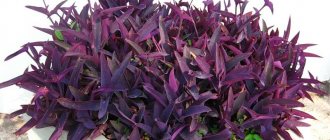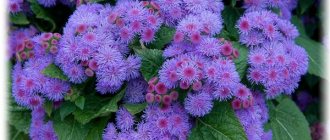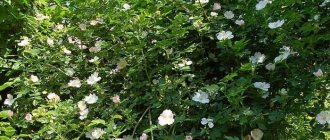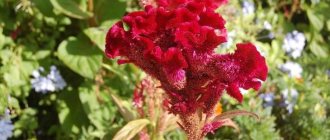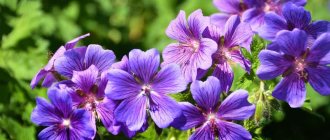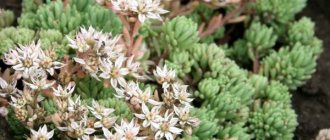Sedum is classified as a succulent from the Crassulaceae family. The plant is otherwise known as Sedum due to its botanical name "Sedum acre". The “nicknames” don’t end there. Popular names for the herb sedum include: acute young, young, whip, squeak, etc.
Bright five-pointed stars will warm the soul even on a cloudy day
Along with other representatives of sedums, the flower is gradually gaining recognition among landscape designers who are developing designs for rock gardens, flower beds, dry streams and other decorative elements and representation of the area.
Description
Sedum ácre is a herbaceous perennial belonging to succulents. The plant of the Crassulaceae family has been known to people since ancient times.
It is no coincidence that it has many other names - “rejuvenator”, “feverish or hernia grass”, “whip” and even “living water”.
Natural habitat - North Africa, Europe. In Russia, it is found naturally in western Siberia, Ciscaucasia. It chooses sandy and dry places for growth - wastelands, embankments, rocky slopes. Found on forest edges and clearings.
The rhizome of the sedum is thin, highly branched, resembling a bunch of tangled cords. Thanks to this rhizome, the plant receives enough moisture from the soil. During prolonged drought, the flower produces surface roots to catch droplets of dew and rain.
The rising stems of sedum do not exceed a height of 15 cm. Their height depends on the composition of the soil. On scanty rocky soil they reach only 7 cm, but under favorable conditions they grow to their maximum. The stems are covered with small, fleshy leaves that are ovoid in shape. Their color is green, and can be dark or light (depending on the planting location and lighting). Special fabrics of the sheet plate accumulate moisture.
The leaves do not fall off in winter; the succulent remains green throughout the winter.
The short inflorescences consist of golden-yellow flowers. Among the five opened petals, 10 stamens are clearly visible. The buds open in May - June, depending on climatic conditions. Flowering lasts until September, after which the seeds ripen. The plant is an excellent honey plant, producing a lot of nectar even in dry weather. Many insects are attracted by the sweet aroma of flowers.
Young bushes take root well and grow quickly. As soon as the short shoots touch the soil, they immediately try to cling to it. Over the course of the season, the succulent grows and by the next summer it is ready to delight flower growers with abundant, bright blooms.
There is a legend about the ability of sedum to be reborn. If you put dried sedum in the ground, sprinkled with soil, it will come to life and sprout!
A selection of photos of sedum in garden design
When creating a garden composition, the designer takes into account many factors. It is important for him that the plants are in harmony. Sedum of various types is indispensable in the decoration of gardens. The evergreen plant is winter-hardy and undemanding in care, used as a bright spot or creates a background.
The main condition is that sedum loves open places. Let it be a slope, a rock or an alpine hill, it would be light. Greening roofs, decorating rock gardens - this hardy perennial is indispensable everywhere. The designer is faced with the task of choosing the most successful sedums in accordance with the artist’s plan. See: hosta flower photo
Classics of the last century
Arsene Castle Garden
Modern manor
Original project
Sedum on a hill
Stones in the greenery of the sedums
The design of garden compositions is not complete without sedums. Unpretentious ground cover varieties are used to decorate small roofs and to create architectural compositions. Bright greenery of different shades creates a unique look according to the artist’s plan. Sedums are used both in hanging structures and in rock gardens. In the spring, when there is little greenery, sedums enliven the garden; in the fall they bloom and play with colors.
Varieties
Sedum acre Aureum
Sedum acre Aureum
This variety of sedum is a decoration for alpine hills and rockeries. It grows quickly, forming lush mats, the height of which is about 8 cm. Small, fleshy green leaves are densely located on ascending stems. Shoots spreading along the ground quickly grow adventitious roots.
Flowering occurs from May to July. Golden-yellow flowers are collected in inflorescences. When they bloom, the green mat changes color, becoming yellow from the numerous opened flowers. During flowering, the foliage also acquires a yellowish tint.
Sedum Aureum is hardy and unpretentious: it is not afraid of drought and frost, and does not lose its attractiveness on poor soils.
Sedum acre Elegans
Sedum acre Elegans
The groundcover plant, reaching an average height of 10 cm, forms turf with a diameter of 20 cm. On branched stems, succulent leaves of green, bluish or purple color are alternately located. Their shape is slightly twisted. The foliage remains on the shoots throughout the winter. Abundant flowering begins in June and lasts about two months. The flowers are light yellow in color and have a diameter of approximately 1.5 cm. During flowering, the perennial “grows” up to 20-30 centimeters.
Sedum Elegance is planted in containers, on rocky walls and alpine hills. A separately planted plant looks impressive as a bright carpet spot or emphasizes the beauty of tall plant crops in the neighborhood.
Sedum acre Minus
Caustic sedum Minus
A very low-growing decorative variety of sedum acridus, forming a mat, the height of which barely reaches 10 cm. The fleshy leaves, which have a bluish-green color, look like small cylinders that turn pink in the sun. Blooms profusely with yellow flowers.
Sedum acre Minus
The flower is popular not only among professional flower growers, but also among beginners. It looks unusual both in group and single plantings. The plant is not afraid of frost.
Preparing sedum for winter
Many types of garden sedums can withstand frosts down to –25-30°C, which allows plants to winter well without shelter. Dense mats of evergreen sedums (for example, Lydian) remain a decoration of the landscape. Among the popular species, frost-resistant shrubby sedum is prominent, creeping sedum is caustic, recurved and densely leafed, most varieties of sedum are white.
More heat-loving species are recommended to be additionally covered or dug up and moved indoors during the cold period. Thus, in the middle zone, spatulate-leaved sedum and pampiniform sedum require shelter. And sissies like Sedum Makina or Morgana do not tolerate frost at all and are only suitable for growing in containers.
Before covering the sedums, their shoots should be cut to a height of 2-3 cm from the ground, after which the bush can be mulched and covered with spruce branches or other suitable material.
If you didn’t have time to trim the sedums in the fall, nothing bad will happen - you’ll just have to do it in the spring to remove all the dead and frozen stems, making room for young shoots.
Sedums are graceful and delicate, yet incredibly hardy plants that can play the main role in a garden ensemble, but more often play a supporting role, emphasizing and highlighting the beauty of the solo “artists.” Meanwhile, this species is one of the most numerous and diverse in nature, and the plants belonging to it definitely deserve a place in your flower garden!
Features of cultivation
Sedum caustic is able to adapt to any climate. It requires a minimum of care; gardeners say about it: plant it and forget it.
Selecting soil and planting location
Sedum is not picky about soil fertility. On the contrary, it feels good in sandy, sparse areas. A loose clay-sand substrate is what the plant needs. You can add a little ash and humus to this mixture.
The simpler the soil composition, the more abundant the flowering.
If the flower is not picky about the composition of the soil, then good lighting is extremely important for it. It is best to plant it in the sunniest area. It will, of course, grow in the shade, but it will not please you with flowering.
Watering, fertilizers, fertilizing
Sedum growing in open ground requires virtually no watering. It receives the required amount of moisture from the soil and precipitation. Watering is needed only during the dry summer period, and then only moderately. Excessive waterlogging of the soil is detrimental to this type of succulent. In its natural environment, the perennial chooses dry areas for growth. There is no need to spray sedum.
The perennial does not need fertilizing. If you really want to feed it, it is enough to apply fertilizer for cacti once a summer.
Loosening
It is recommended to loosen the soil around young sedum bushes to prevent it from souring. In addition to loosening, mature overgrown “mats” must be weeded regularly.
Transfer
When transplanting several sedum bushes to a new location, it is important to maintain a certain interval between them - at least 25 cm. This distance is necessary for the growth of daughter shoots. You can replant throughout the warm season: from May to October.
Divisions or rooted cuttings are placed in the planting hole, sprinkled with soil substrate, and watered with a small amount of water.
Trimming
Pruning should be carried out in order to rejuvenate the sedum and give it a decorative appearance. The procedure can be performed at any time convenient for the grower, from spring to autumn.
The appearance of the perennial will itself indicate the need for pruning: with extensive growth and thickening, the color of young leaves will become faded, and the flowers will become sparse and very small.
In this case, the old stems of the sedum are removed, dried and deformed, and drooping flowers are also cut out.
Wintering
Adult specimens feel good at low temperatures, maintaining their attractiveness even under snow. Young bushes require winter shelter. They can be covered with fallen leaves or special covering material. In spring, release the sedum from its shelter.
Care
| Lighting | A very important factor for sedum. Only with sufficient lighting is it possible for the plant to bloom and retain the bright color of the foliage. If the lighting is insufficient, the sedum may stretch out, losing its decorative effect. If the plant is kept in the house, then it is recommended to regularly wipe the leaves from dust so that it does not delay the flow of light, but if the sedum grows on the site, you need to make sure that dry leaves from the trees do not remain on it. This plant will not be able to break through the decline layer in the spring. |
| Temperature | Sedum does not require strict adherence to the temperature regime; it is comfortable in both warm and cool conditions. The optimal temperature is from 8 to 26 degrees in summer. With proper care it can withstand higher temperatures. Winter is a dormant period for sedum. At this time, the required temperature for its maintenance is 8-10 degrees. If the room is too warm, the shoots will stretch and become deformed. |
| Location | It is best to place sedum at home on the windowsills of southern windows, remembering the extreme light-loving nature of this plant. But if it is direct sunlight with a tightly closed window, the plant will simply wither. It is best to move the sedum outdoors in the summer months; if this is not possible, then it is necessary to ensure a flow of fresh air into the room. |
| Watering | Sedum is a succulent, so excessive watering is contraindicated for it. Waterlogged soil is a direct path to plant death, especially in winter. In spring and summer, watering is carried out as the top layer of the substrate dries. In winter, sedum is watered once every four weeks. The plant does not need spraying; you can only wipe the leaves to remove dust. |
| Air humidity | There is no need to take special measures to humidify the air for sedum. Due to the characteristics of its natural growth, it tolerates dry air well. |
| Top dressing | It is recommended to feed sedum only in spring and summer. Fertilizers for cacti. There is no need to introduce fertilizers in the autumn-winter period. |
| The soil | For sedum, special soil for cacti from a flower shop is suitable, but you can prepare the substrate yourself by mixing turf and leaf soil, brick chips and sand in a ratio of 2:2:1:2. You can add a little charcoal. Good drainage is also important for the plant. |
| Trimming | After flowering ends, the sedum’s flower stalks need to be cut off so that the plant does not become depleted. |
Reproduction methods
Sedum acrid can be propagated in three ways.
Cuttings
Cut off the shoot for planting with a sharp knife. Remove the lower leaves. Plant it in a loose substrate for rooting to a depth of one node. Plant the rooted cuttings (after 3-4 weeks) in a permanent place.
In spring, cuttings can be rooted immediately in open ground, when frost has passed. In autumn, cut shoots should be placed in water until roots appear. Then plant them in separate containers. In the spring, transplant into an open area using the transshipment method for continuous growth.
Seeds
It is better to sow seeds in March. After sowing, they must undergo a stratification (hardening) procedure. Seeds in a planting container are placed in a cool place for 2 weeks. After this, they are placed in a warm place for germination with a temperature of at least 18 degrees. The top of the box must be covered with film or transparent glass to create a greenhouse effect. The crops are ventilated daily and moistened as the soil substrate dries.
In about 25–30 days, the first shoots will emerge. Seedlings are picked when two strong leaves appear.
At the end of May - beginning of June, seedlings are planted in open ground in a permanent place. The distance between plants should be at least 10 cm for further growth. Sedum blooms in the third year after planting.
Dividing the bush
Dig up a heavily overgrown bush and divide it into several parts, each of which should have a growing point. Sprinkle sections of the root system with charcoal or treat with fungicides. Replant to a new site.
Diseases and pests
Excess and stagnation of moisture in the soil can provoke the formation of rot on the root system. The disease spreads quickly if it is not stopped in time.
The “sluggish” leafless shoot needs to be dug up, the rotten roots should be cut off, and the cuts should be sprinkled with coal. Plant the reanimated plant in a new area. Another way to save it is to root the top of the succulent.
The roots of perennials are often affected by a fungal infection, which manifests itself in the form of swellings, growths and death of rhizome tissue. The methods of control are the same as for the formation of rot. Healthy parts are treated with fungicides.
The most dangerous pest for sedum are nematodes.
Their appearance is indicated by the appearance of the flower: sluggish, drooping shoots. The sedum stops growing. Swellings form on the roots. Necrosis of the root system leads to the death of the entire sedum. There are no means to combat parasites yet. The infected crop must be dug up and burned. You can plant marigolds or garlic in this area; other plants will become new victims of pests.
Possible difficulties
- Slow growth.
Usually characteristic of the period after transplantation. The fact is that at this time the sedum is actively growing its root system or gaining strength for flowering, while the growth of the above-ground mass stops. - Pests attack flowers.
For the most part, pests are not dangerous for caustic sedum, due to the toxicity of the juice of its leaves, but attacks on flowers do occur. The control method is simple - you need to mechanically remove the damaged parts of the plant.
Caustic sedum is a worthy alternative to flowering ground covers that require careful care. Unpretentious and highly decorative, it successfully wins the sympathy of gardeners every year.
We invite you to familiarize yourself with other types and varieties of sedums, namely Matrona, Lizard, Burrito, Voodoo, Brilliant, Morgana, Blue Pearl, Kamchatsky, Herbshtfreude.
Useful properties and contraindications
A representative of the Crassulaceae family has medicinal properties. Decoctions and ointments, which include sedum, are used to treat skin inflammations and pustules, calluses, and remove warts. It is necessary to carefully lubricate only the diseased areas; healthy skin can be burned.
In homeopathy, preparations with plant juice are used as laxatives and diaphoretics. They help relieve epilepsy attacks.
Do you have any doubts about what to plant in your garden plot? Plant caustic sedum - a minimum of care for this representative of the flora will save time for busy gardeners. And the result will not be long in coming - sunny inflorescences and decorative foliage will evoke only positive emotions.
Obvious advantages of cultivation
Gardeners who have risked planting sedum on their property have already noted the benefits of cultivating the latter. Thus, the plant tolerates insufficient humidity and calmly tolerates prolonged drought.
Harsh winter is also not terrible for the flower. Snow feather beds can not only reliably protect sedum roots from freezing, but also preserve the bright green of succulent stems and leaves.
Sedum is a perennial. This means that gardeners only need to root the plant once and not have to go through the procedure of sowing or cuttings every year.
And finally, a flower creeping across an area so tightly covers the ground (rocky, tiled) and other surfaces that it will hide any design mistakes or force majeure defects from prying eyes.
In general, sedum is an ideal solution for decorating a summer cottage garden. By the way, some connoisseurs of the Crassulaceae family manage to grow the perennial as an indoor flower!
